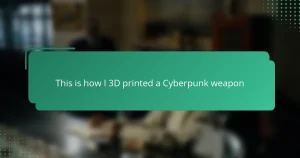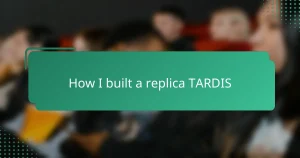Key takeaways
- Science fiction props, such as the Stargate, blend art and technology, creating immersive experiences that inspire customization and creativity.
- Design elements like intricate glyphs, textures, and lighting enhance the authenticity and storytelling of the props, making them feel more lifelike.
- Common challenges in prop customization include balancing details with practicality, sourcing materials, and managing hidden wiring for lighting effects.
- Personalizing props through small modifications and detailing can transform them into unique reflections of the creator’s story and creativity.

Understanding Science Fiction Props
Science fiction props are more than just objects; they are gateways to other worlds and stories. From my experience, holding or customizing a prop like a Stargate makes me feel connected to the universe it represents, sparking creativity in ways I never expected.
Have you ever wondered how a prop’s design influences your imagination? The intricate details and functionality—not just the look—give a prop its authenticity. When I customize a prop, I focus on these subtle elements to breathe life into something originally created for the screen.
What truly sets science fiction props apart is their blend of art and technology. I’ve found that understanding this balance helps me respect the craftsmanship behind each piece while inspiring my own customizations. It’s a fascinating process that invites both logical thinking and imaginative exploration.
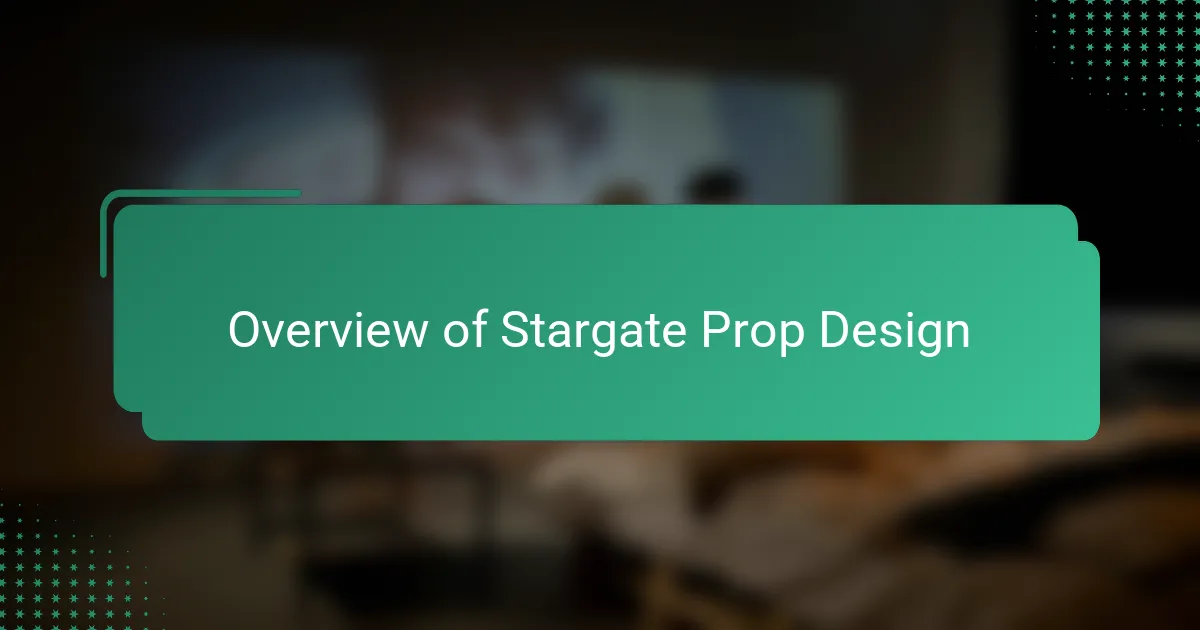
Overview of Stargate Prop Design
When I first examined the Stargate prop design, I was struck by how its circular form isn’t just visually iconic but also functional within its fictional universe. The glyphs and chevrons aren’t random decorations; they serve as a kind of cosmic map, which makes me appreciate the thoughtful layering behind the design. Have you noticed how these small elements make the prop feel like a real device rather than just a costume piece?
The use of weathered metal textures and complex light interactions adds to the prop’s believability. In my experience customizing Stargate replicas, replicating that aged, used look was one of the toughest but most rewarding challenges—it transforms a static object into something that seems to have a story etched into every inch. It’s these textures that make the Stargate seem lived-in and functional, bridging the gap between fantasy and reality.
What really fascinates me is how the prop balances simplicity and complexity. Its basic circular shape is approachable, but the detailed mechanisms hidden within invite curiosity and exploration. This is the kind of design that keeps me coming back, pushing me to find ways to honor the original while adding my own creative touches. Have you ever felt that pull to both preserve and personalize something so iconic?
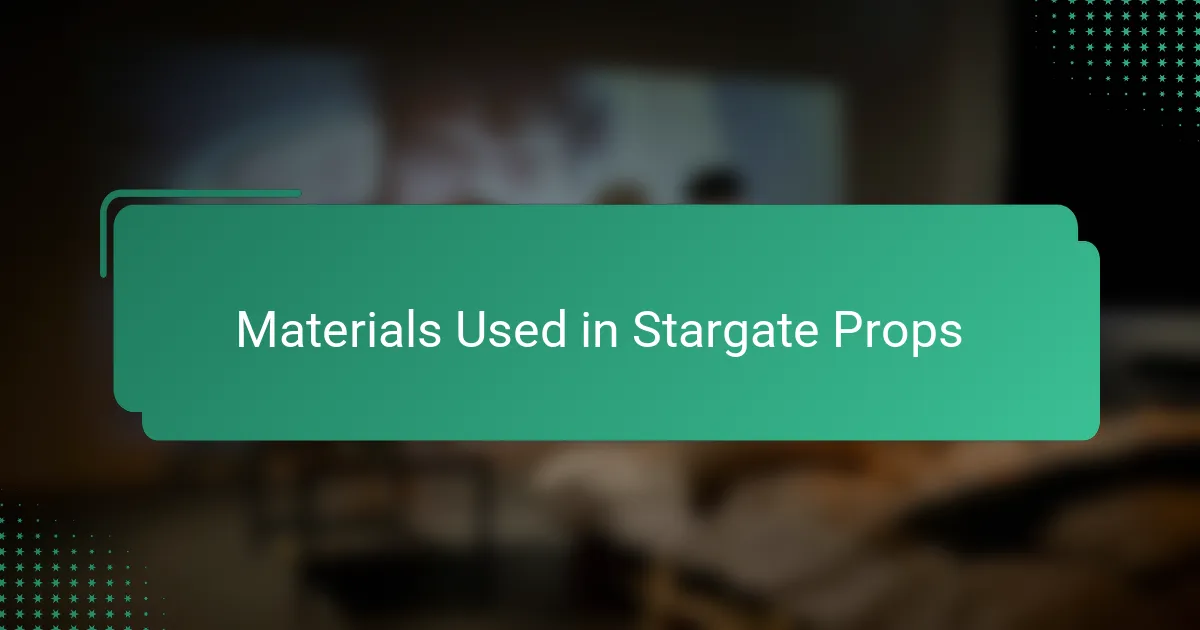
Materials Used in Stargate Props
The primary materials used in Stargate props often include resin and fiberglass, which offer a great balance between durability and weight. When I first started working with these materials, I was surprised by how easily they allowed me to carve and shape details, making the glyphs and chevrons come to life just like on screen. Have you ever tried sculpting with resin? It’s fascinating how something so rigid can be molded into such intricate forms.
Metal components also play a critical role, especially for the chevron mechanisms and the outer ring’s structural elements. From my experience, incorporating lightweight metals like aluminum not only adds authenticity but also keeps the prop manageable during customization. There’s something satisfying about the cold touch of metal pieces that really grounds the Stargate in reality, don’t you think?
Additionally, I found that using LED lights paired with translucent acrylic for the inner ring amplifies the Stargate’s mystique. Lighting can transform a static piece into a dynamic portal, and experimenting with different light intensities became one of my favorite parts of customizing. Ever noticed how subtle illumination can completely change the feel of a prop? It’s a little detail that sparks wonder every time I turn it on.

Techniques for Customizing Stargate Props
One technique I’ve grown fond of involves weathering the Stargate’s surface to mimic years of intergalactic travel. Using a combination of dry brushing and washes with dark acrylics, I bring out the raised details like glyphs and chevrons, making the whole piece feel lived-in rather than brand new. Have you ever tried that trick? It’s like telling a story through paint, where every smudge adds character.
Another approach I swear by is integrating functional lighting to replicate the Stargate’s iconic glow. I like embedding tiny LEDs behind translucent panels, which not only enhances realism but also amps up the prop’s atmosphere during display or cosplay. The challenge here is wiring everything discreetly, so the tech doesn’t distract from the overall look—something I learned the hard way on my first build.
Sculpting additional details or swapping out parts can also take a Stargate prop from good to outstanding. For instance, I once carved custom chevron grips using modeling clay, then cast them in resin to maintain durability. Adding those little personalized touches keeps me engaged and often sparks new ideas for future projects. Do you find these small modifications just as satisfying as the big structural changes? For me, they’re equally rewarding and make the prop uniquely mine.
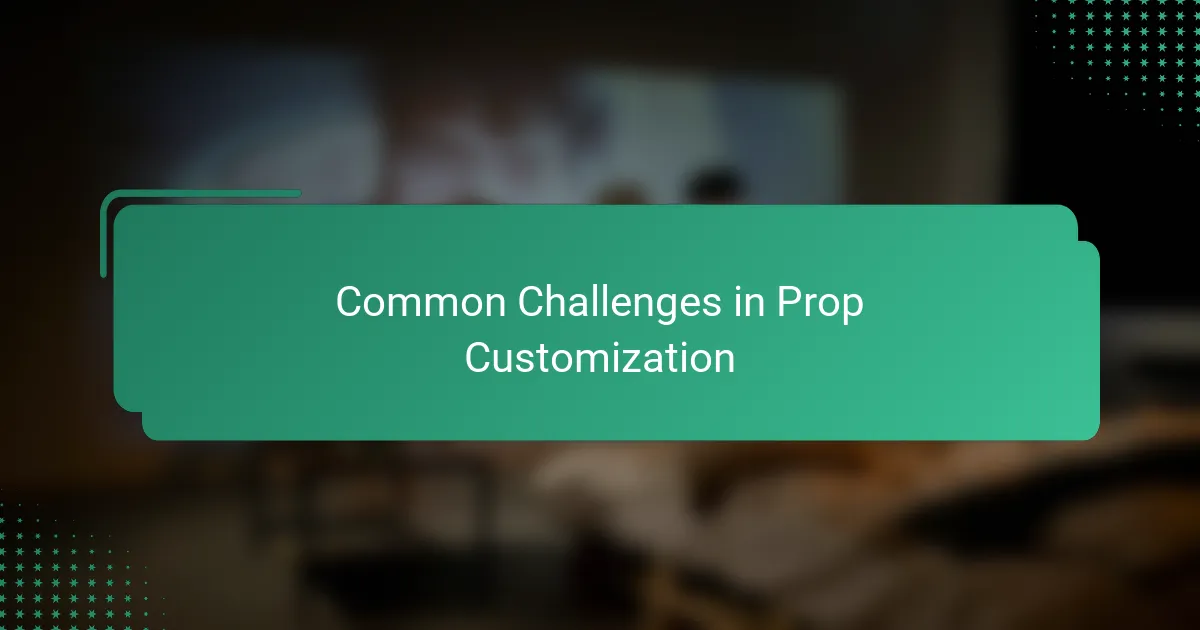
Common Challenges in Prop Customization
One challenge I often face when customizing a Stargate prop is balancing accuracy with practicality. The original designs are incredibly detailed, which excites me, but replicating every tiny glyph or texture without making the prop unwieldy can be tricky. Have you ever spent hours trying to perfect a detail, only to realize it adds too much weight or fragility? It’s a fine line to walk.
Another hurdle is sourcing materials that both look authentic and are easy to work with. Early on, I remember struggling to find the right resin that would capture the right sheen without cracking during sanding. It taught me that patience and experimentation are just as important as technical skill in prop-making.
Lastly, hidden wiring for lighting always seems to throw a wrench in my plans. Fitting LEDs and power sources into tight spaces without compromising the Stargate’s sleek look requires a lot of trial and error. I recall spending an afternoon re-routing wires just to keep everything discreet—frustrating, yes—but the glowing effect makes it all worthwhile. Have you ever felt that mix of frustration and satisfaction when a tricky detail finally comes together?

Personal Experience with Stargate Prop Customization
Customizing my Stargate prop was as much a journey of patience as it was creativity. I remember the first time I tackled the intricate glyphs—it felt like decoding a secret language, and each precise carving brought a wave of satisfaction that’s hard to put into words. Have you ever experienced that moment when the painstaking details suddenly make the whole piece feel alive?
There was also this one evening I spent fiddling with the LED placements to get the ring to glow just right. It was frustrating when the wires didn’t fit as neatly as I hoped, but seeing that soft, pulsating light finally illuminate the portals made every tangled wire worth it. Moments like these make me appreciate the blend of art and engineering that goes into such a prop.
What struck me most during customization was how personal the process became—each weathered scratch or carefully painted symbol felt like I was embedding a part of my own story into the Stargate. Have you noticed how customizing a prop can turn it from a static replica into a reflection of yourself? That’s the magic that keeps me coming back for more projects.
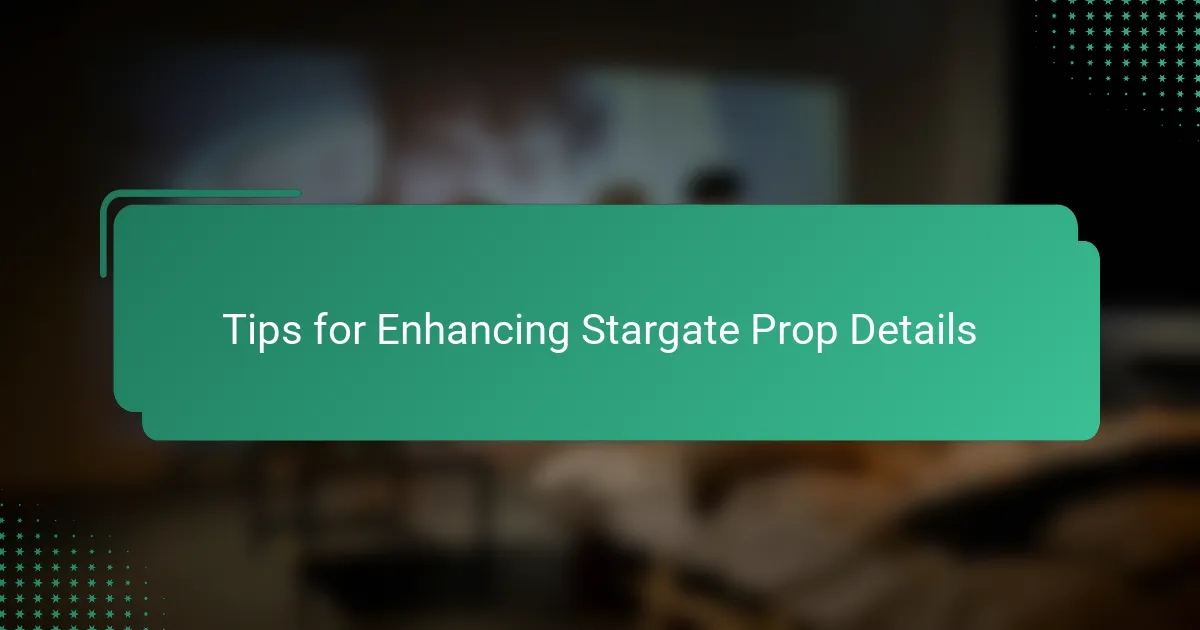
Tips for Enhancing Stargate Prop Details
Enhancing the details on a Stargate prop often comes down to layering textures and highlights. I like to use a mix of dry brushing and subtle washes to accentuate the glyphs and chevrons—it’s amazing how a little contrast can make those tiny symbols pop and instantly bring the prop to life. Have you ever noticed how something as simple as emphasizing raised edges can change the whole vibe?
Adding small, realistic imperfections also does wonders for authenticity. I remember one time I lightly chipped the paint around the outer ring to mimic battle scars, and suddenly the Stargate felt like it had a history beyond the screen. Those little touches create stories that invite viewers to imagine where the gate has been and what it has witnessed.
Lighting is another game-changer when it comes to details. I enjoy experimenting with different LED placements to achieve that subtle, ethereal glow inside the inner ring. It’s tricky hiding wires and keeping the setup sleek, but once the lights switch on, the Stargate transforms from a static prop into a dynamic portal—a moment that never fails to draw me in, and I bet it would do the same for anyone else too.

